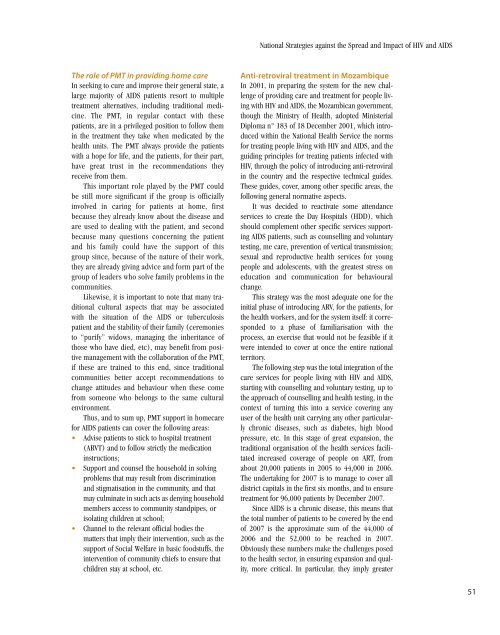English language version - Human Development Reports - United ...
English language version - Human Development Reports - United ...
English language version - Human Development Reports - United ...
- No tags were found...
You also want an ePaper? Increase the reach of your titles
YUMPU automatically turns print PDFs into web optimized ePapers that Google loves.
National Strategies against the Spread and Impact of HIV and AIDSThe role of PMT in providing home careIn seeking to cure and improve their general state, alarge majority of AIDS patients resort to multipletreatment alternatives, including traditional medicine.The PMT, in regular contact with thesepatients, are in a privileged position to follow themin the treatment they take when medicated by thehealth units. The PMT always provide the patientswith a hope for life, and the patients, for their part,have great trust in the recommendations theyreceive from them.This important role played by the PMT couldbe still more significant if the group is officiallyinvolved in caring for patients at home, firstbecause they already know about the disease andare used to dealing with the patient, and secondbecause many questions concerning the patientand his family could have the support of thisgroup since, because of the nature of their work,they are already giving advice and form part of thegroup of leaders who solve family problems in thecommunities.Likewise, it is important to note that many traditionalcultural aspects that may be associatedwith the situation of the AIDS or tuberculosispatient and the stability of their family (ceremoniesto “purify” widows, managing the inheritance ofthose who have died, etc), may benefit from positivemanagement with the collaboration of the PMT,if these are trained to this end, since traditionalcommunities better accept recommendations tochange attitudes and behaviour when these comefrom someone who belongs to the same culturalenvironment.Thus, and to sum up, PMT support in homecarefor AIDS patients can cover the following areas:• Advise patients to stick to hospital treatment(ARVT) and to follow strictly the medicationinstructions;• Support and counsel the household in solvingproblems that may result from discriminationand stigmatisation in the community, and thatmay culminate in such acts as denying householdmembers access to community standpipes, orisolating children at school;• Channel to the relevant official bodies thematters that imply their intervention, such as thesupport of Social Welfare in basic foodstuffs, theintervention of community chiefs to ensure thatchildren stay at school, etc.Anti-retroviral treatment in MozambiqueIn 2001, in preparing the system for the new challengeof providing care and treatment for people livingwith HIV and AIDS, the Mozambican government,though the Ministry of Health, adopted MinisterialDiploma n° 183 of 18 December 2001, which introducedwithin the National Health Service the normsfor treating people living with HIV and AIDS, and theguiding principles for treating patients infected withHIV, through the policy of introducing anti-retroviralin the country and the respective technical guides.These guides, cover, among other specific areas, thefollowing general normative aspects.It was decided to reactivate some attendanceservices to create the Day Hospitals (HDD), whichshould complement other specific services supportingAIDS patients, such as counselling and voluntarytesting, me care, prevention of vertical transmission;sexual and reproductive health services for youngpeople and adolescents, with the greatest stress oneducation and communication for behaviouralchange.This strategy was the most adequate one for theinitial phase of introducing ARV, for the patients, forthe health workers, and for the system itself: it correspondedto a phase of familiarisation with theprocess, an exercise that would not be feasible if itwere intended to cover at once the entire nationalterritory.The following step was the total integration of thecare services for people living with HIV and AIDS,starting with counselling and voluntary testing, up tothe approach of counselling and health testing, in thecontext of turning this into a service covering anyuser of the health unit carrying any other particularlychronic diseases, such as diabetes, high bloodpressure, etc. In this stage of great expansion, thetraditional organisation of the health services facilitatedincreased coverage of people on ART, fromabout 20,000 patients in 2005 to 44,000 in 2006.The undertaking for 2007 is to manage to cover alldistrict capitals in the first six months, and to ensuretreatment for 96,000 patients by December 2007.Since AIDS is a chronic disease, this means thatthe total number of patients to be covered by the endof 2007 is the approximate sum of the 44,000 of2006 and the 52,000 to be reached in 2007.Obviously these numbers make the challenges posedto the health sector, in ensuring expansion and quality,more critical. In particular, they imply greater51
















